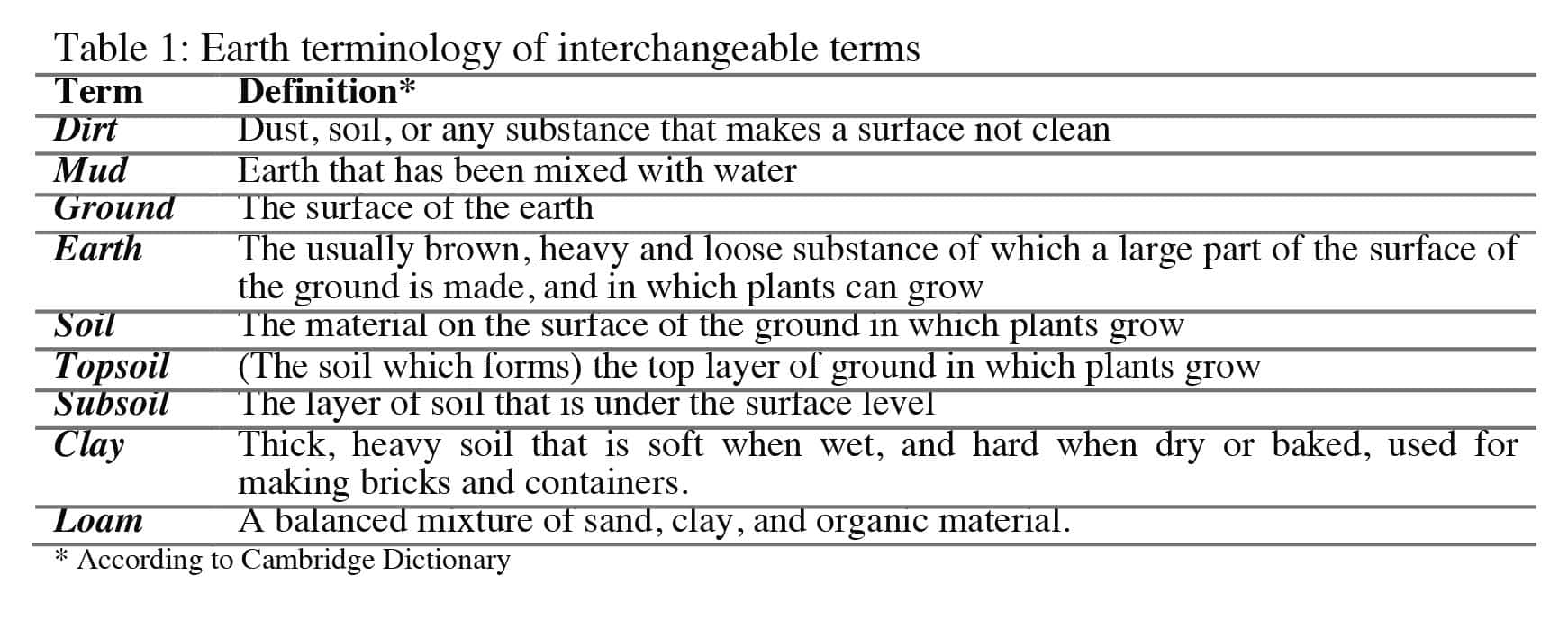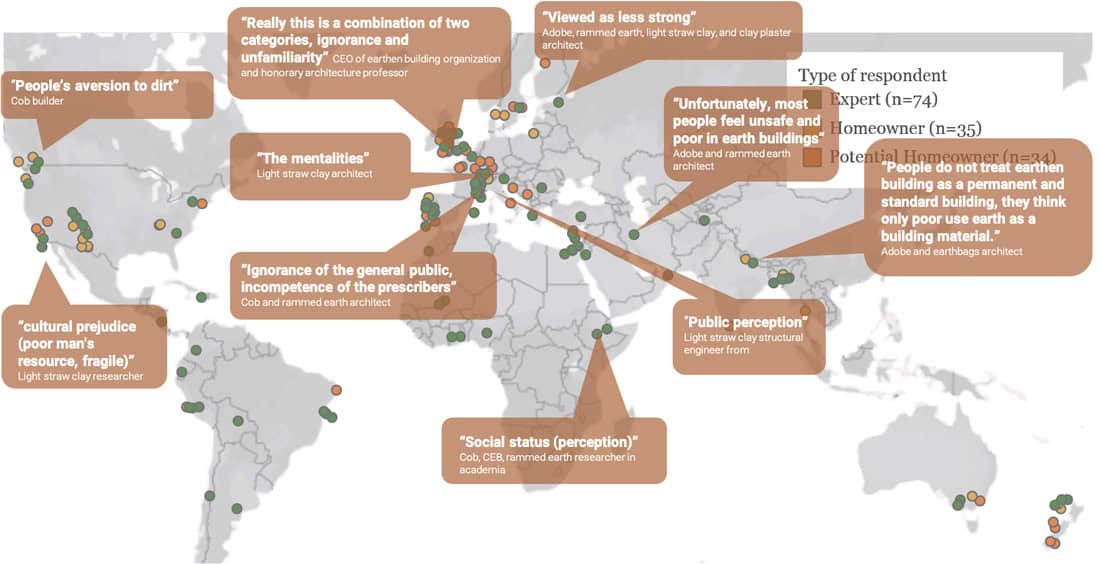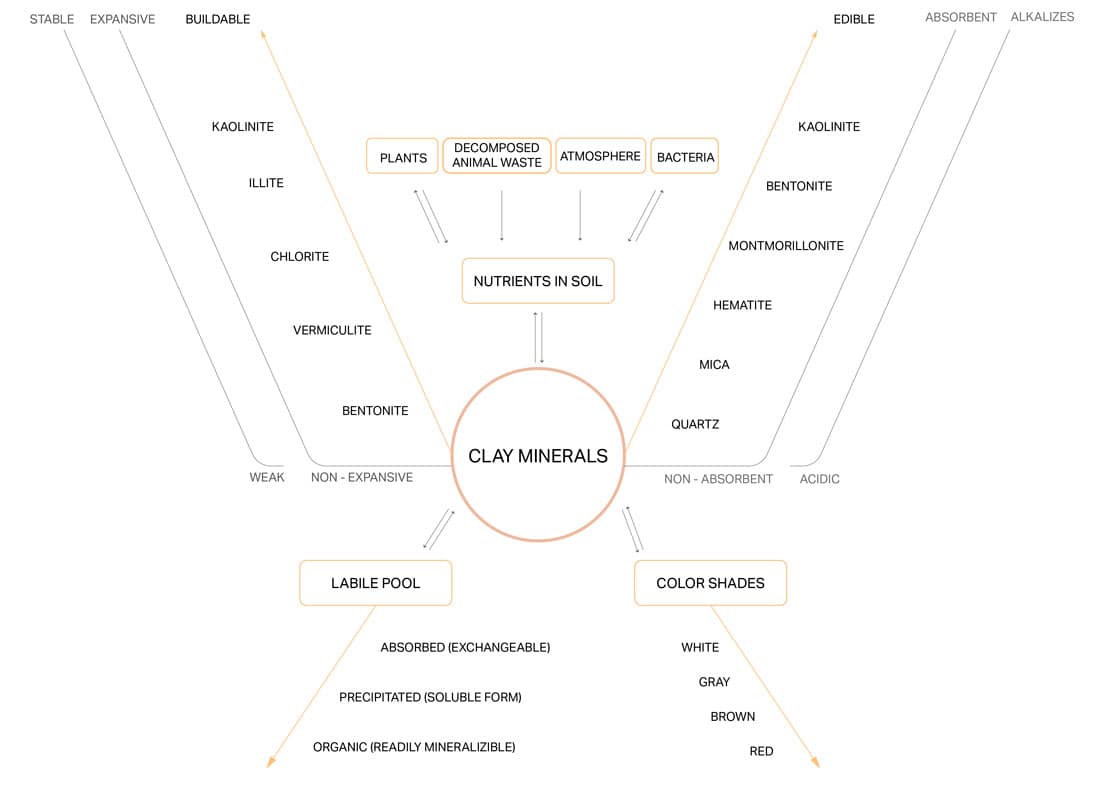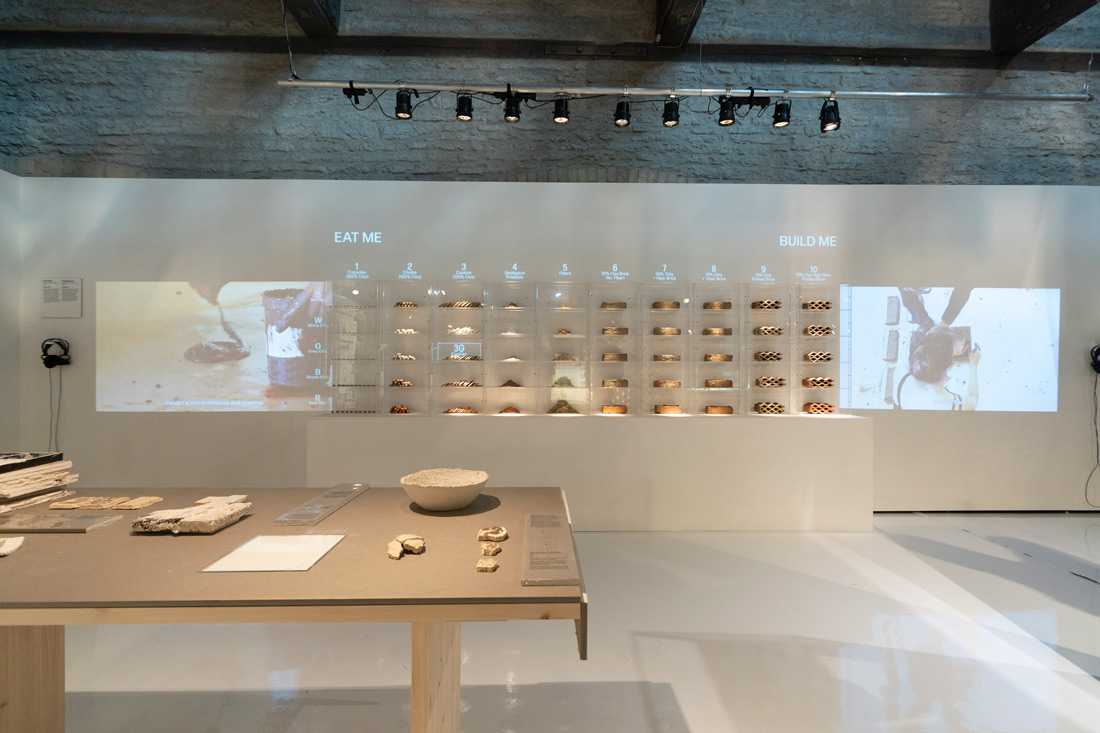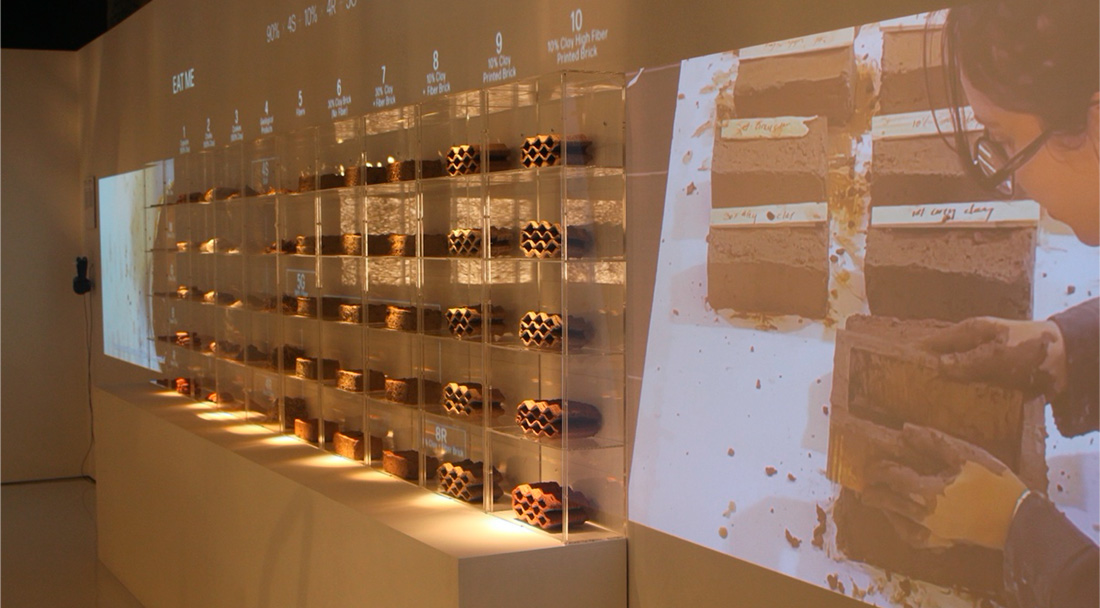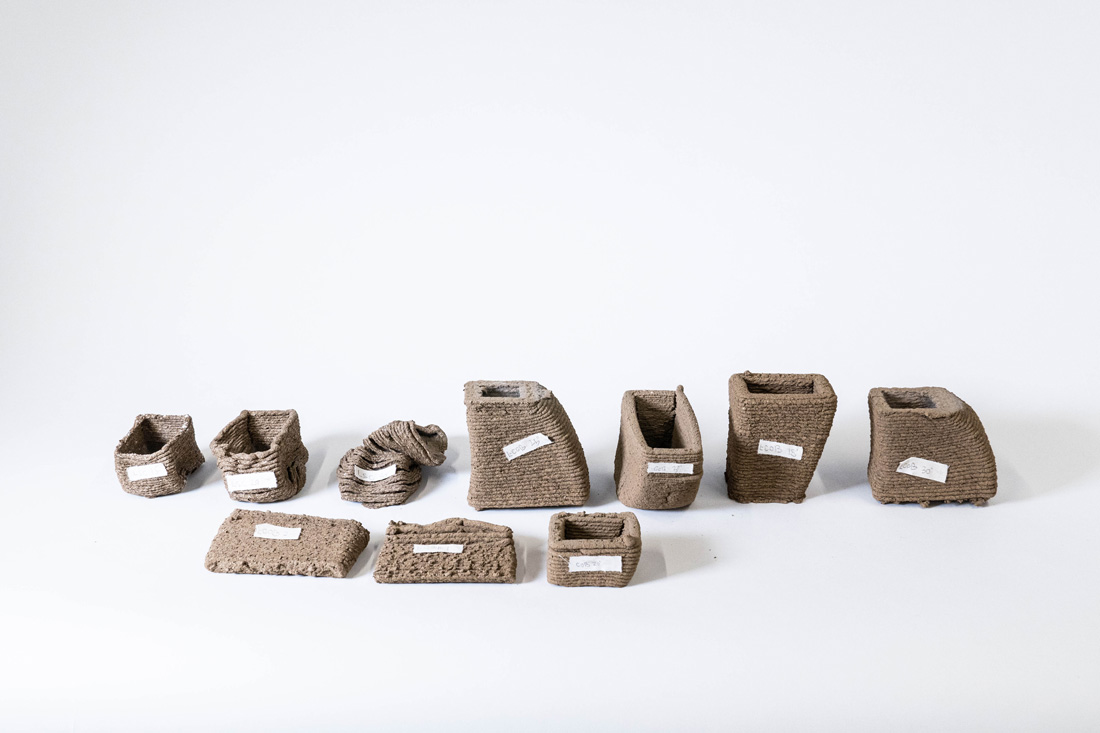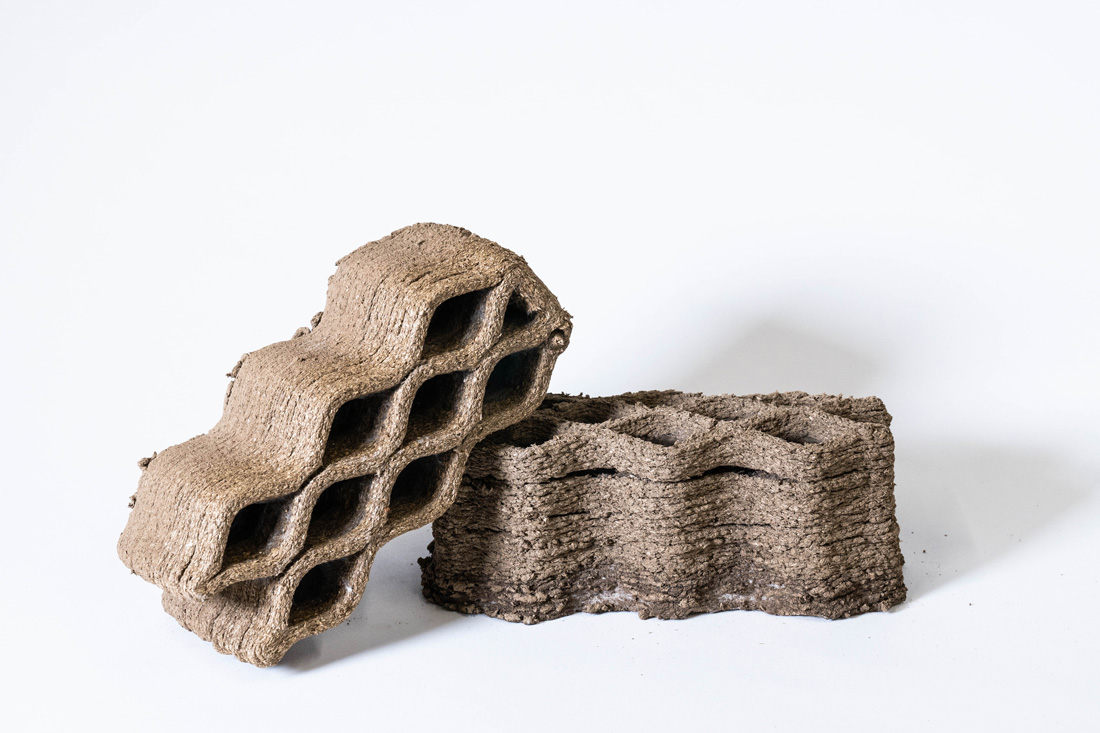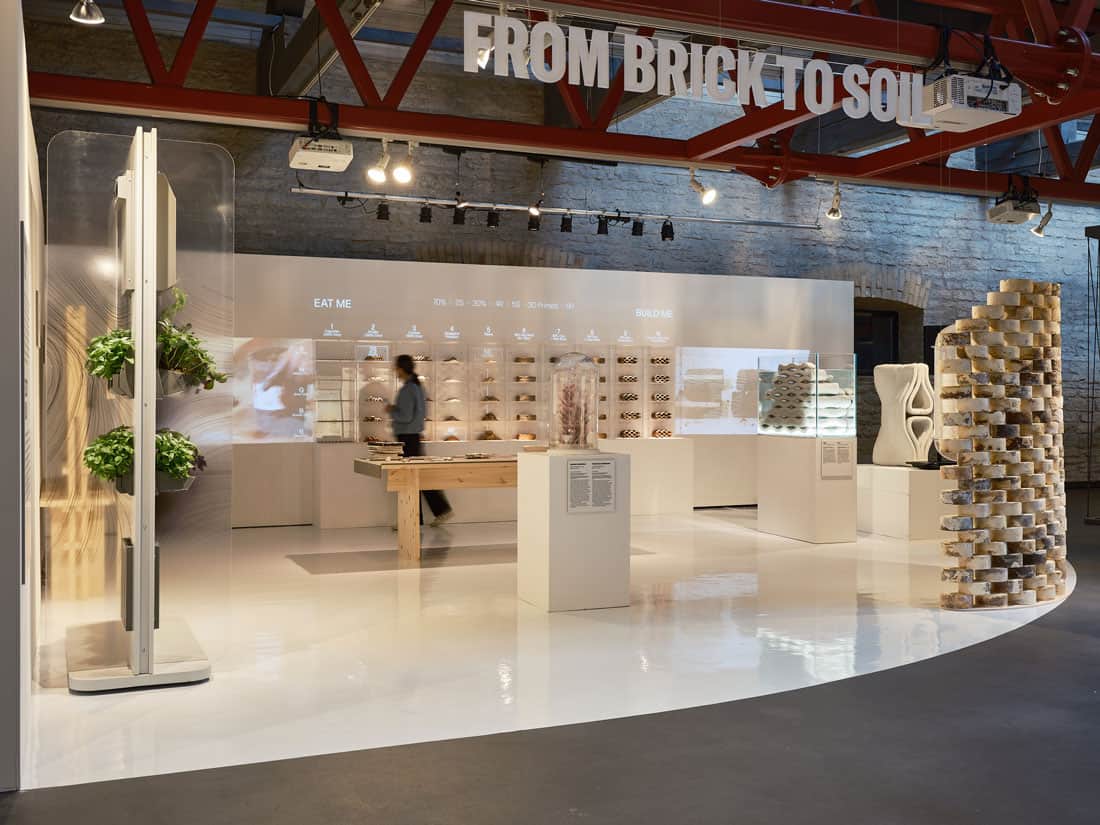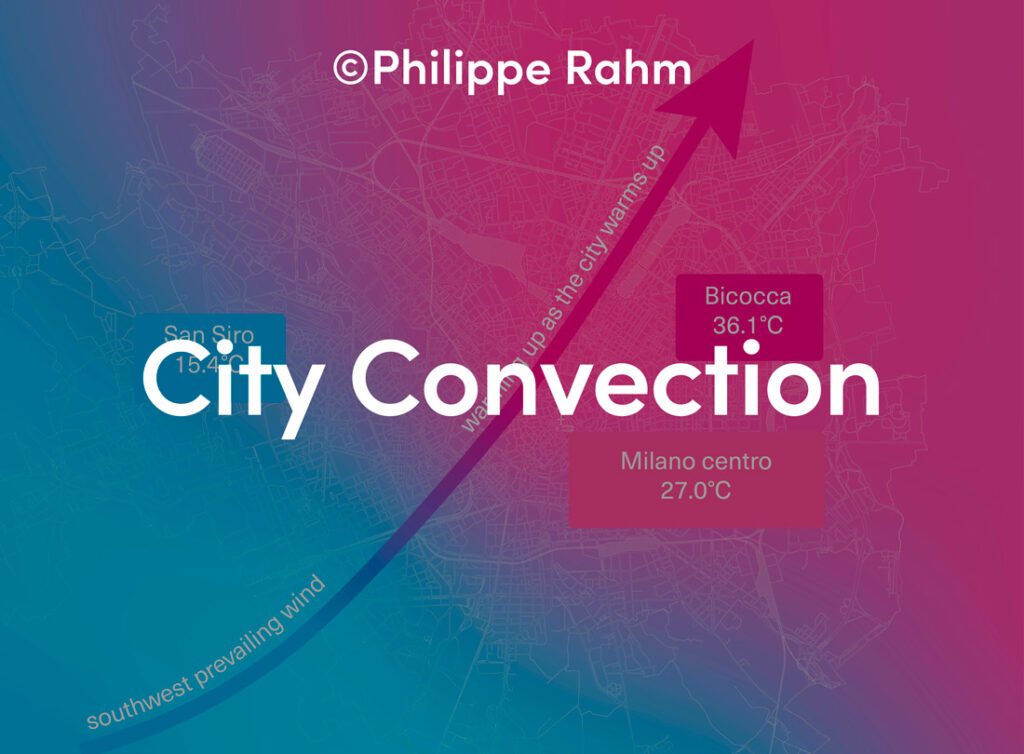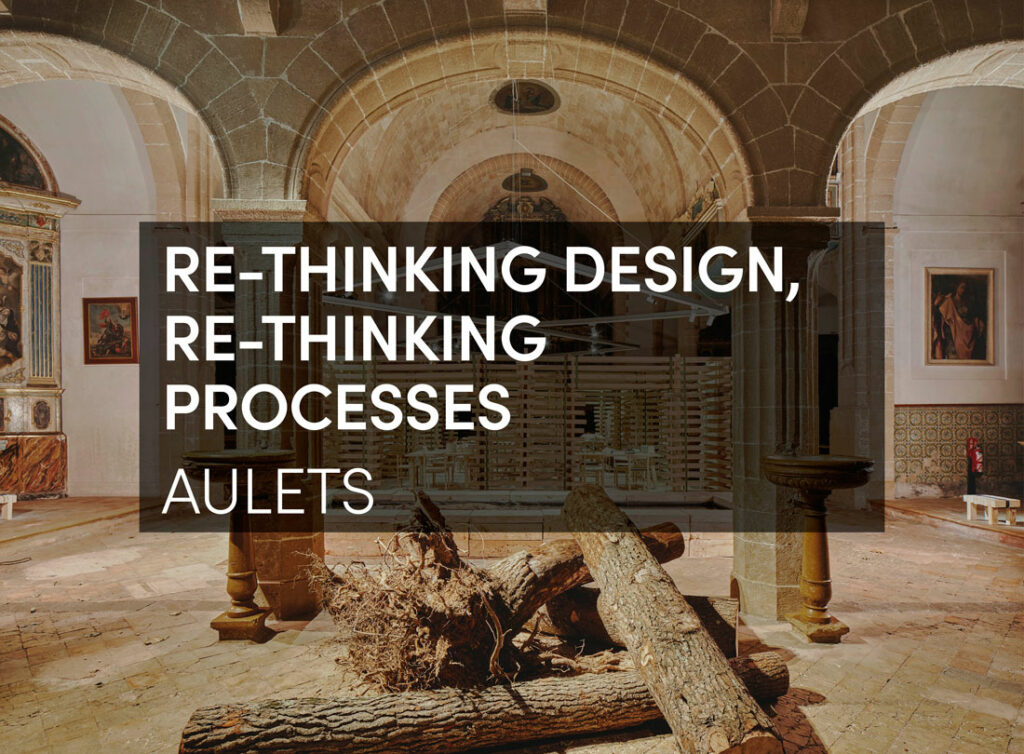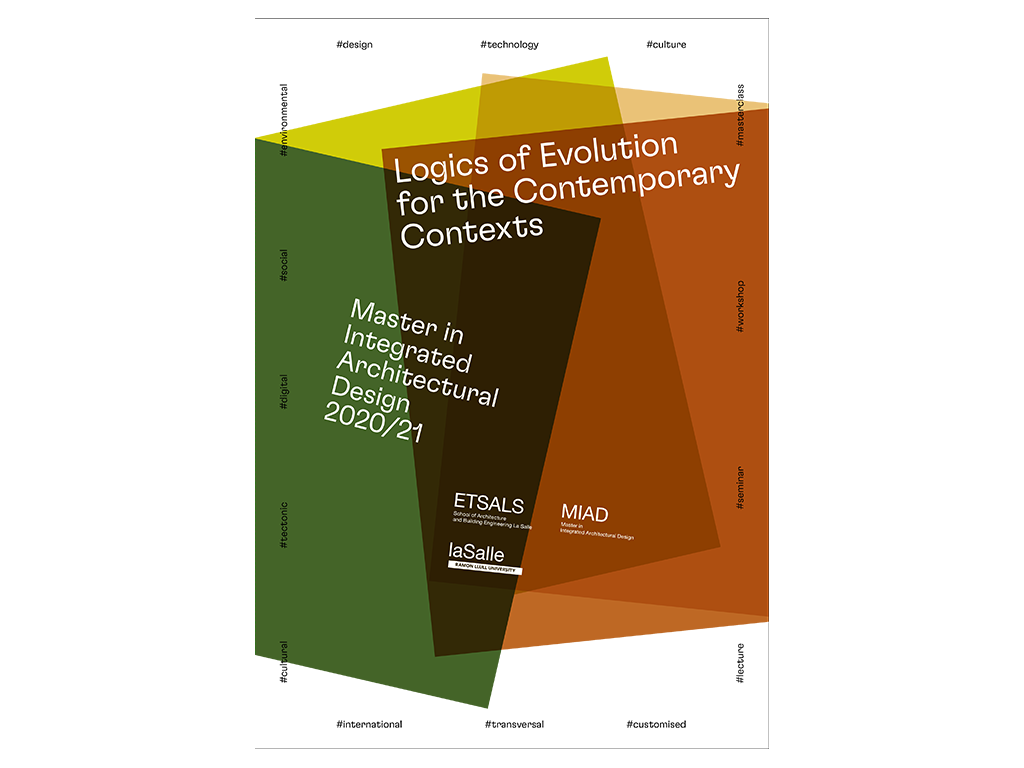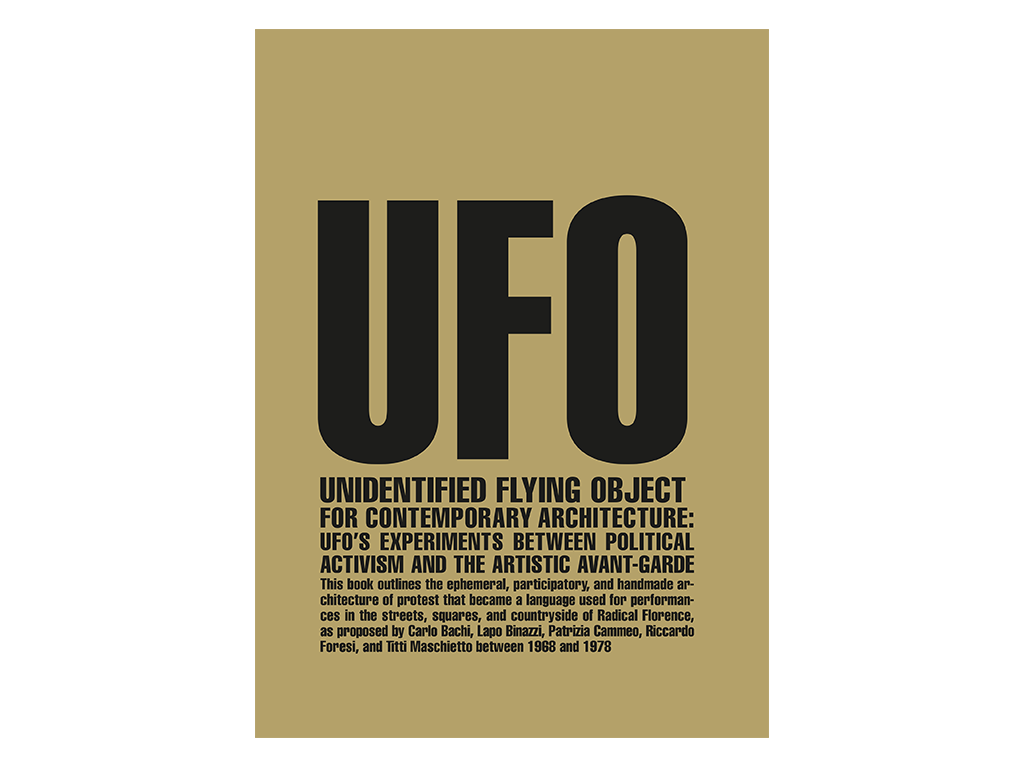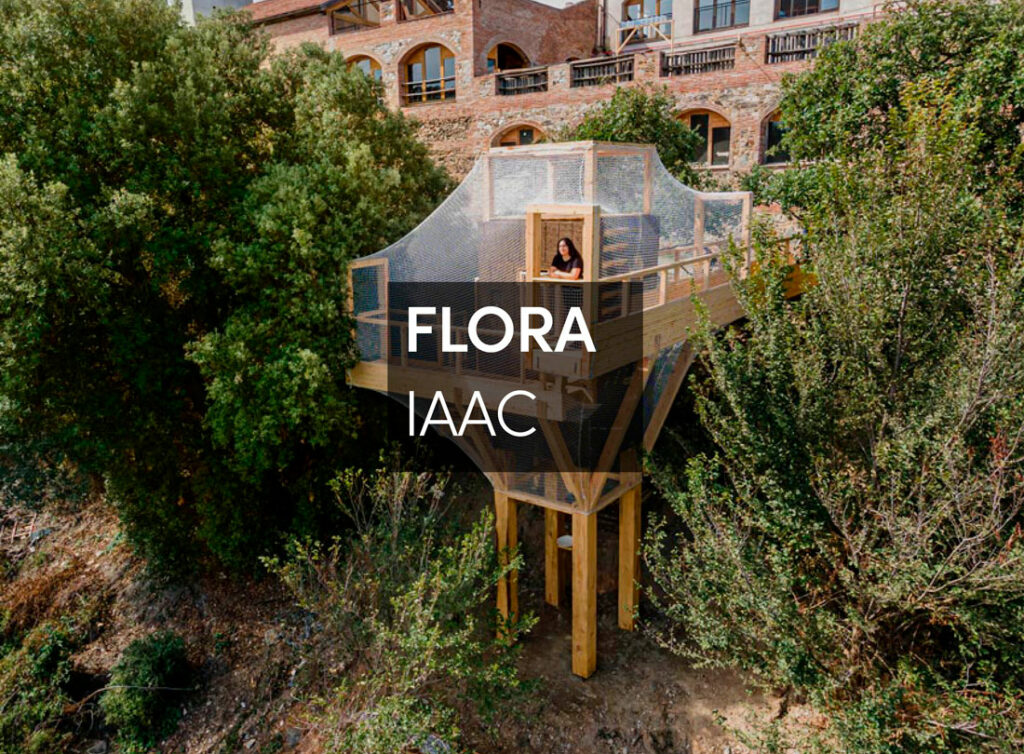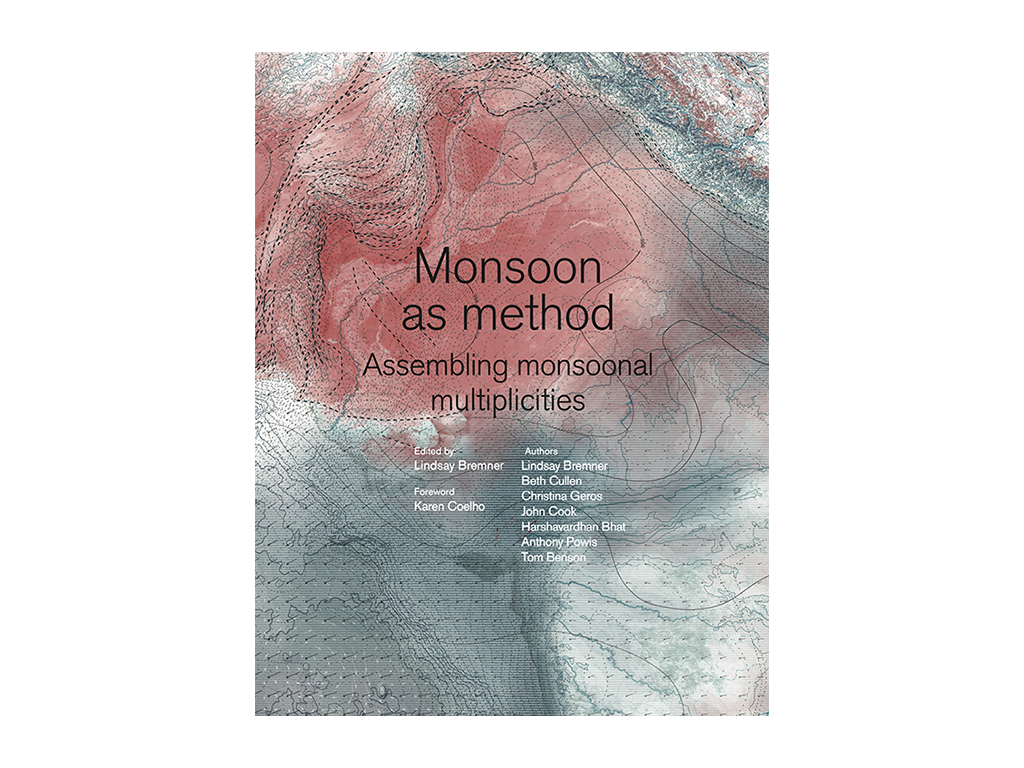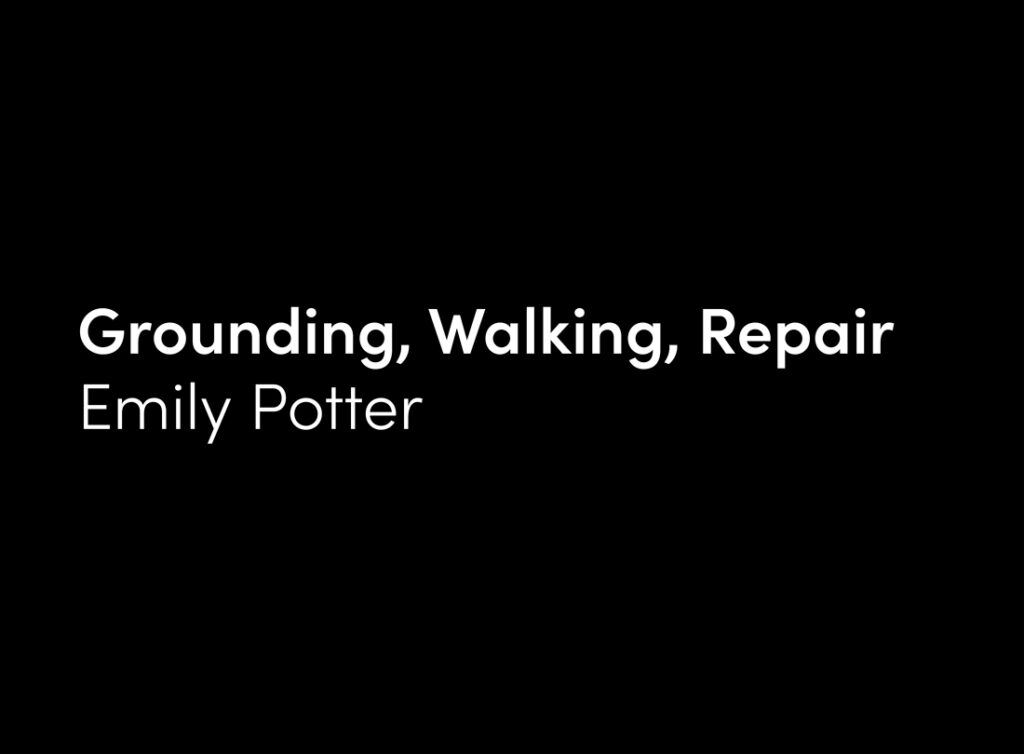The use of earth-based materials (namely, mud or dirt architecture) appears in two practices throughout history: in the construction of buildings and – less commonly known or conclusively understood – in certain dietary consumption patterns. To put it simply, soil, the most important nutrient collector on earth, can be used for both building and for eating.
Used for over millennia and still sheltering approximately one-third of the world’s population, earth-based building materials include a range of mix designs comprising clay-rich soils and vegetable additives constructed in various techniques, such as adobe, cob, rammed earth, and light straw clay. Negatively perceived as poor in their performance, earth materials are undergoing a process of “engineering” to gain further insight into their mineralogical and particle characterization with the ultimate goal of enhancing their structural capabilities and durability.
In a similar manner, clay-rich soils have traditionally been used as edible substances in almost every global region. Traditional recipes such as bonbon tè (Haitian mud cookies), calabash chalk (West Africa) and terra sigillata medicorum (Central and Eastern Europe) have been used as part of the human diet for religious beliefs, in traditional local medicine, or as part of a regular menu. Studies in the field of edible clay have shown that pregnant women crave dirt, clay, or charcoal if their bodies are deficient in key minerals.
Negative modern interpretations of using earth have emerged in both practices. When it comes to building, earth materials are often perceived as “dirty” and the poor man’s choice for housing; the lyrics of the Medieval English folk song, “London Bridge Is Falling Down” tell us that “wood and clay will wash away.” As a food source and in medicine, earth is associated with the pathology and poverty-associated practice called geophagia. In investigating the past of each tradition, this work speculates about the contemporary and future possibilities of using earth as a nutritional resource for the built environment. This investigation relies on the convergence of anthropology, history, and building technology to examine and rediscover supply chains of readily available earth-based materials for both building and nutritional substances.
This work asks, what are the “recipes” for earth substances that can used within the built environment to also enhance healing? Using low- and high-tech methods, we tested raw soils for their particle content and mineralogy, while mapping their constructive and edible potentials, with the objective of identifying whether clay-rich soils can serve as durable building façades that can also be edible if the need arises. Following a mineralogical study, an exhibition presents, analyzes, and compares earth artifacts’ compositions from the buildable to the edible.
Traditional practices of using earth as an edible substance (left) and as a building material (right). Image sources: AP Photo/Ariana Cubillos, Science Photo Library/David R. Frazier.
First Step: Clarifying Earth Terminology
Soils, especially those rich in silicates, are the most abundant solid substance in both the oceanic and continental crust (Schulze 2018). Yet, before addressing the science of consuming and building with earth, in order to dispel confusion on interchangeable terms, we will offer a much-needed clarification of the terminology associated with earth substances. Table 1 is intended to dispel confusion regarding interchangeable terms.
Shifting Western Biases: From Scarcity to Passive Survivability
Today, traditional practices of using earth as an edible substance and as a building material are often associated, with a negative perception. Shown in Figure 2, a global perception survey has identified the extent of the negative perception of earth materiality worldwide. As part of this survey questionnaire, earth building experts repeatedly mentioned that, in their experience, there is a “poor public perception” and “aversion to dirt” that creates a strong barrier to implementing earth materials in mainstream construction.
Selected excerpts from the perception survey among earthen building experts, including architects, engineers, and builders from 12 different countries, who mentioned the perceptual gap when it comes to using earth materials in construction projects, due to cultural prejudice and negative social perception.
Experts also elaborated on the relation between poor perception and socioeconomic prejudice; for instance, an architect from a seismically active region who works with rammed earth and adobe mentioned that “unfortunately, most people feel unsafe and poor in earth buildings”. An architect from Southeast Asia who uses adobe, earthbags, and clay plaster added that “people do not treat earthen building as a permanent and standard building; they think only poor [people] use earth as a building material.” Lastly, some experts mentioned that another barrier is the lack of available technical data, and “lack of information on new developments and recent good examples”.
Earth building was pushed aside during the colonizing processes of industrial modernization due to the introduction of industrialized materials such as Portland cement.[1] As the dictates of architectural modernism and developmentalism (postwar international development) took root around the world, the desire to replace earth – a labor-intensive, highly variable material that is difficult to standardize – with mass-produced parts aligned with global economies of scale relegated earth building to the sidelines.
Material shifts tied to colonialism led to the replacement – or erroneous imitations – of native practices. Left: traditional Palestinian stone with clay mortar that was replaced by Portland concrete brought during the British Mandate. Right: Tanzanian villagers pounding mud for adobe bricks. Wood engraving by an unknown artist, 1889.
Yet, earth construction, as a sustainable architectural practice, embodies a profound wisdom that transcends scarcity. The utilization of earth in construction establishes a symbiotic relationship with local biomes, textures, and colors. From an anthropological standpoint, earth architecture has encapsulated narratives and unique cultural identities, embodying resilience and adaptability, ingenuity and the enduring power of maintenance. Looking through the lens of future survivability in the face of climate change, earth materials prove their potency in providing adaptive comfort zones using passive design approaches, alongside strikingly lower diurnal temperature swings in extreme climates, from hot arid zones to cold steppes. Heat indices and passive survivability patterns reveal that conventional wall systems with greater insulating properties (insulated CMU, for instance) have a greater number of annual “extreme caution” hours, highlighting the counterproductive behavior of insulation in retaining solar and internal heat gains.[2]
From the point of view of indoor environmental quality, earth assemblies have been shown to act as passive removal systems for harmful volatile organic compounds (VOCs),[3] while exhibiting excellent moisture buffering capacities, acting as a relative humidity “fly-wheel” that absorbs and desorbs moisture from and to the air while maintaining optimal humidity levels for human comfort. Economically, earth construction can be extremely affordable, due to the use of readily available materials from or around the construction site, such as the soils that are excavated for foundations. Therefore, building with earth is arguably healthier for both the inhabitants and installers/construction workers.
The Three Hypotheses for Eating Earth: Food, Nutrient, and Detox
Current-day biases against the idea of earth-eating can be traced to the perceived causal link between three hypotheses: hunger (people eat earth because they are hungry), nutrient deficiency (people eat earth as an instinctive way to supplement missing nutrients), and detox (people eat earth to absorb toxins).
As a pathology, earth consumption has been viewed as a psychiatric disorder involving the unconstrained urge to consume earth, mud or dirt. Not only was it considered harmful to the consumer’s health and digestion system, but the interchangeable use of “earth,” “ground,” and “dirt” also evoked notions of excrement, filth, and the dangers of decay. Eating earth as a desperate last resort in the face of food scarcity and hunger was the favored explanation for geophagy among colonial explorers in Oceania, the Americas, and Africa. This view reached to extreme of severe punishments for dirt-eating slaves by owners who believed these behaviors were acts of resistance.
However, recently, attitudes have begun to shift regarding these phenomena: a growing body of scientific evidence shows that eating earth can be traced to evolutionary advantages and can, in specific ways, provide certain benefits to its practitioners. Attitudes toward the eating disorder geophagia were derived from modernity’s standardization of hygiene and the emphasis on sanitation. Today, scientists have arrived at a more nuanced understanding of microbiomes, including the one inside the human body, and their vital contributions to an individual’s overall health. The critical role that gut bacteria and other microorganisms play in metabolic processes and the immune system has proven to be of particular relevance for the reframing of geophagy.[4]
Unexpectedly, eating clay has also emerged in the last decade as a lifestyle fad in the health and beauty sector. An ABC News piece titled “Eating dirt might be good for you” (Lallanilla 2005), exemplifies Geophagia’s current-day reincarnation as an ancient health practice worth giving a try. Bloggers sharing their experiments with eating clay often cite a statement from actress Shailene Woodley in an interview with David Letterman in 2014 as a major catalyst for the practice’s commodification (Wong-Shing 2020). Woodley’s statement was covered by The Guardian and used by the BBC as the lead in their article “Who, What, Why? Why do people eat clay?” (BBC News 2014). In this arena, sparked by the media coverage, curious people primarily purchased bentonite clay and embarked upon geophagy for its purported detoxification benefits.
The Mineralogical Common Ground
Soil is formed from the natural weathering of rocks in processes that require millions of years for the formation of soil to occur. Cohesive soils are composed of both clay and non-clay minerals. Within the soil, clay minerals are the essential component for supporting plant growth, and on a metabolic chemistry level, clay counts as an adsorbent mineral. Clay minerals consist of some 15 ordinarily classified minerals that belong to three main groups: kaolin, illite, and smectite. Among non-clay minerals, the most commonly found mineral is quartz (which can constitute up to 90% of soil) and iron compounds such as goethite, siderite, and carbonates such as calcite. Clay minerals differ from other minerals due to their cation exchange capacity and their ability to absorb water.
The extent to which a certain clay can act as a buildable and edible substance depends on how stable, labile, or bioavailable the mineral is (i.e., able to be made workable during construction and/or be absorbed by the body). Clays are good at adsorbing positively charged molecules’ cations, which means that clays can offer an organism protection by binding toxins and pathogens to them before they can even reach the gut wall.[5] In other words, clay can deactivate toxins not by destroying them, but by grabbing them before they can be digested, adsorbing them into some of the space in its crystalline structure. Unwanted chemicals and pathogens trapped in clays then move out of the body with other solid waste.
The suitability of clay minerals for eating and building with thus shares important similarities: for both practices, Kaolin has been a favorite. Kaolin has been shown to reduce nausea and poison-related sickness and death (Liu et al. 2005), while also being an ideal clay mineral for earth construction. Water is less able to penetrate between its molecular layers; thus, it exhibits higher compressive strengths and reduced swelling on wetting.[6]
Surprisingly enough, both the buildable and edible parts of soil share a common mineralogical base: clay. Regardless of their geographic locale or cultural habits, traditional earth-based recipes come with clear instructions on what type of soil is to be use and where it should be sourced from. They all have in common the use of clay-rich soils, which displays minimal organic microbacterial activity. Although in everyday speech, “clay,” in its plastic, moldable state, is associated with mud and dirt, in its particle state, when not suspended in water, it looks much like other particles of rocks that humans use as spices.
Characterization diagram for clay minerals as a buildable substance and an edible substance.
Demonstrating through Installation: the [Eat Me Build Me] Project
The mineralogical examination was demonstrated through a hands-on production of edible buildable artifacts. The result was an architectural installation called The [EAT ME BUILD ME] Project and presented at the 2022 Tallinn Architecture Biennale along with the text “Edible: Or, The Architecture of Metabolism” (Kallipoliti and Markopoulou 2022). As a case study, the installation examined raw earth, with and without fibers, infused with clay minerals, while asking questions such as: Can we develop edible clay building components that can absorb toxins? Can readily available soils be used as both buildable and edible substances?
Inspired by the Periodic Table of Elements, the visual language of the installation formed a matrix arrangement from buildable to edible earth artifacts, as detailed in Figure 5. On the edible side, earth cookies, chalks, and capsules were presented, replicating traditional recipes while also offering modern interpretations for using earth as a food supplement. On the buildable side, manually and digitally fabricated bricks showcase the state-of-the-art in manual and digital earth construction while introducing fiber (straw) reinforcement additives for enhanced strength, durability, and lightweight-ness. A light projection was developed to map the consistency of each element and round out the reference to the periodic table.
The hands-on process of the [EAT ME BUILD ME] project traced traditional methods and developed new “recipes” for earth elements: from chalks to cookies and bricks.
On each side of the matrix, as shown above, a video projection was developed to document the fabrication processes, alongside depictions of buildable and edible earth practices as seen from a Western point of view.
The 3D printed brick experiments using varying mineral content
As an experiment, the [EAT ME BUILD ME] project aimed to expose the similarities and reveal the almost parallel historical and geographic routes of building with and eating earth. It envisioned a larger scope for building supply chain mechanisms, where earth-based materials are perceived not as ineffectual, but as a multidimensional resource that can be used for both shelter and a food source, thus offering a futuristic perspective within a growing field of knowledge that is investigating healthier substances in building materials. The final installation result, shown in Figure 10, exhibited ideas and investigations into the nature/culture divide that governs existing paradigms of the environment. While it literally maps the raw soil and clay minerals for their buildable and edible potentials, the experimental setup also produces a map of these various ideologies and their tensions, towards a reformulation of how we live in the world.
A view of the final installation at the 2022 Tallinn Architecture Biennale
The installation served as both a tactical and conceptual exercise, investigating readily available earth-based materials that can serve as both building materials and nutritional substances. It offered a unique perspective on the human metabolism and on nutrition derived from ingesting the buildings around us. As a speculative architectural installation, the project aimed to radically suggest that possible earth- and bio-based assemblies can be incorporated into building façades as natural, healthy, nontoxic, and presumably edible building mass. To further stretch the idea of the green façade, where food is grown on fabric systems or in containers, the uniqueness of this experiment stems from its use of agricultural nutritional substances – namely farm-to-building and building-to-table – as a source of minerals, nutrients, and superfoods within the building itself: an architecture that can be consumed.

